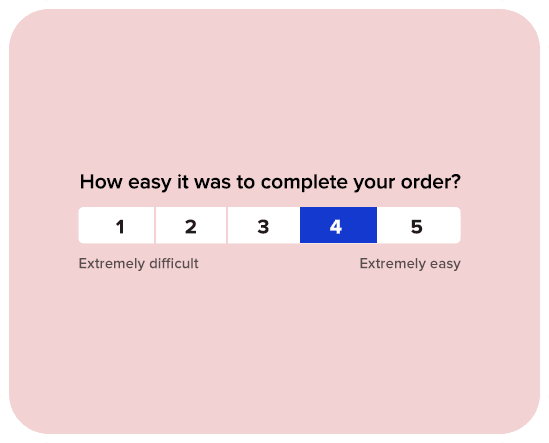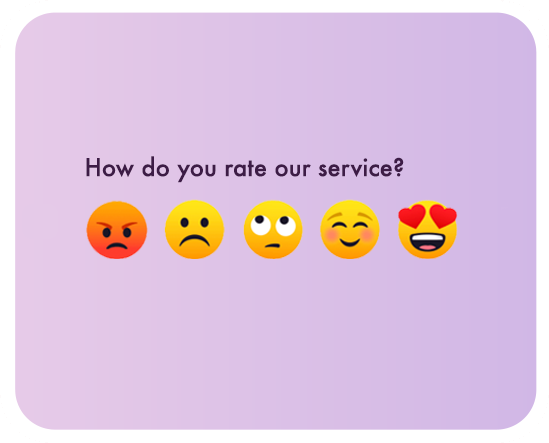7 min read
Listen and understand your customers. Win them at any stage of their journey.
cx Platform
The Customer Effort Score (CES) is one of several metrics companies use to measure customer satisfaction. As a rule, one question determines how much effort the customer took to find a solution to the request or problem. Measuring it can help you accurately predict future business successes or failures.
What is Customer Effort Score?
The customer Effort Score (CES) can be determined using a customer satisfaction survey. It refers to how much effort the client puts into solving their problem. This includes inquiries or issues relating to products, services, or the purchasing process (e.g. using an online store).
CES Goals
The overriding goal of companies is to satisfy customers and, thus, to keep them in the long run – this increases the chances of the further economic success of the company. Returning customers are those for whom the interaction with the company, the purchase process, and even the submission of service requests did not require any effort. Therefore, the following rule applies: the fewer effort customers have to put in to meet their expectations, the more likely they will remain loyal to the company. This important aspect of customer satisfaction can be measured with CES. More specifically, by determining the Customer Effort Score, companies can find out the following:
- how much effort customers have to put into interacting with them,
- whether corrections or changes are necessary, e.g. in customer service, to improve the quality of customer service.
Customer Effort Score: scale
Several metrics can be used to measure Customer Effort Score, but they can change how surveys are calculated and scored:
1. Likert scale – this method includes a “strongly disagree/strongly agree” scale, which is structured as follows:
- I strongly disagree,
- I disagree,
- I disagree a bit,
- Undecided,
- I agree to some extent,
- I agree,
- I definitely agree.
The answers are usually numbered from 1 to 7, and each can be color-coded to make things more visually intuitive for respondents (for example, ticking “Strongly Agree” in green and “Strongly Disagree” in red).
2. Scale 1-10
It consists of the fact that respondents offer answers to a question in the range of 1-10. Generally, segments 7-10 are associated with positive responses (for example, if you ask customers how easy it was to do something). However, if your question asks the respondent to rate their level of effort, segments 1-3 will instead be associated with positive scores (since they represent low effort).
3. Scale 1-5 – in this case, the answer options are as follows:
- very difficult,
- difficult,
- none,
- easy,
- very easy.

4. Emoji icons
While this metric is quite simple, it is useful if you do a lot of CES surveys on minor aspects of your product/service/site. In addition, it makes it easier for respondents to answer. Basically, you are using images as an answer
- smiling face,
- neutral smiley,
- sad face.

When is the right time to submit a CES survey?
CES online surveys are sent to customers at the following key times:
1. After the interaction that led to the purchase.
Sending Customer Effort Score surveys after a customer has interacted with your product/service or service team and ultimately made a purchase is a great way to collect real-time feedback on improvements that need to be made to improve the buying process. For example, when a customer signs up for a free trial or ends the onboarding period.
2. Right after the customer interacts with the service department
Sending a CES survey after contacting customer support (such as email support tickets) lets you quickly find out how efficient your support team is and if any changes need to be made to increase overall performance. You should also consider sending a survey like this after the customer has finished reading your knowledge base article, as this will help you find out how useful your content is.
How to frame a customer effort question?
To begin with, you need to ensure that the wording is as unambiguous as possible. Only ask customers something that has something to do with their efforts. Also, the tone of your question should be neutral so that the respondent does not feel you are trying to favor a particular answer. Make sure your CES survey flags your area of analysis – the overall customer experience with your website/brand or just a single moment of customer interaction (e.g. live chat).
Apart from using different answer choices, you can also frame the question differently. Here are some variations that you can try out:
- How much effort did you have to put in to solve your issue?
Answer choices from 1 (low effort) to 7 (high effort) - [Name of support rep] made it easy for me to solve my problem
Answer choices from strongly disagree to strongly agree - [Name of the business] made it easy for me to find a solution to my problem
Answer choices from strongly disagree to strongly agree - It was easy for me to [mention the action taken, like completing a transaction or signing up for a trial]
Answer choices from strongly disagree to strongly agree
Customer Effort Assessment: Advantages and Disadvantages
Benefits
One of the great things about CES surveys is that they are practical and specific – they can quickly show you which areas need improvement to improve your customer experience. In addition, the results of the Customer Effort Score turned out to be a strong predictor of future purchasing behavior. In fact, according to the HBR study, approximately 94% of customers who reported experiencing “low effort” with the company confirmed that they would purchase again. The same research also shows that CES can give you an idea of how likely customers are to recommend a particular brand to others and how they would talk about it. In general, around 81% of customers who reported having put in a lot of effort interacting with a company said they intended to speak negatively about the brand. It can therefore be assumed that consumers who are satisfied with the low level of effort required from them are likely to recommend the brand to others or at least speak positively about it.
Disadvantages
While the downsides of CES aren’t groundbreaking, they’re worth highlighting. First of all, by evaluating the customer’s effort, it can’t tell what the consumer’s relationship with the brand is. In addition, CES cannot confirm how factors such as competition, products, and prices affect customers and their ratings. CES surveys may tell you that a customer had difficulty solving a problem, but they need to explain why. For example, if a consumer says they’ve had a hard time trying to get something your brand can’t offer, that’s not an appropriate score for your business. The customer experience is an ever-changing process, which is why it’s so important to measure your customer effort score continuously – and to respond to any negative feedback that may arise. Keep an eye on trends and consistently work to make all processes in the company so easy to use that customers will be happy to use your services.
Translating reduced effort into increased customer loyalty is not all you can gain by conducting CES Customer Effort Score online surveys. The study will help your company, among others:
- receive hard proof that an attempt to exceed customer expectations in customer service, i.e. broadly understood customer service – often such a costly and absorbing mission – should not always be the company’s goal,
- obtain information on which touchpoints are the weakest and why they are rated as “effort”, i.e. why the customer effort indicator is so high,
- focus on preparing and training employees of the so-called frontline – they are crucial for good customer interaction.
Create an account on the Responsly platform or use the free 7-day test access and get to know all the possibilities of the website. Check out the ready-made Customer Effort Score survey template and start measuring the level of effort customer experiences when they interact with your business.






